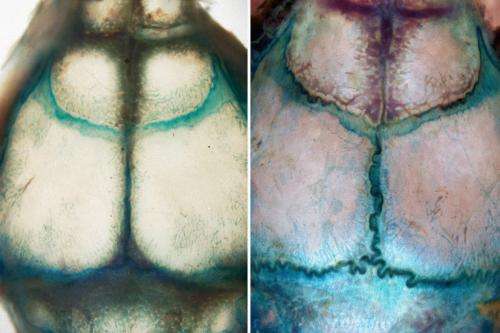Discovery could lead to biological treatment for common birth defect

USC researchers have discovered which stem cells are responsible for the growth of craniofacial bones in mice—a finding that could have a profound impact on the understanding and treatment of a birth defect that can lead to an array of physical and intellectual disabilities in humans.
In an article published in the April issue of Nature Cell Biology, Professor Yang Chai describes how he and postdoctoral fellow Hu Zhao identified a population of Gli1+ stem cells within the mesenchyme of tissue between the bones of the skull, known as cranial sutures.
Chai's research team noted that if Gli1+ cells were eliminated from the sutures, the craniofacial bones experienced growth arrest and weakening, leading researchers to conclude these cells were indispensable in healthy skull development.
The findings could have a significant impact on the treatment of craniosynostosis, a birth defect affecting one in 2,500 births.
An infant's soft spot
In a normally developing baby, the craniofacial bones do not grow together for up to 18 months to allow for the brain to reach nearly 70 percent of its eventual size. It's these open sutures that cause babies' heads to have "soft spots."
In an infant with craniosynostosis, the skull bones fuse together before the brain has fully developed, which can cause an array of problems, including hearing and vision defects and developmental disorders.
"Traditional scientific literature viewed craniosynostosis as an overgrowth of bone," said Chai, holder of the George and Mary Lou Boone Chair of Craniofacial Biology. "Our findings offer a brand new perspective, which is that craniosynostosis could actually be viewed as a lack of stem cells."
The discovery could lead to a different treatment intervention for babies with craniosynostosis. Up until now, if the bones prematurely fused, a doctor had to operate, typically within the first year of the baby's life. The surgery entails removing the top of the child's skull, cutting it into segments and then stapling it back together, creating enough space for the infant's developing brain to grow.
Thanks to the discovery of Gli1+ stem cells, this mechanical intervention could soon be replaced with a biological intervention—something Chai and his team are already working on.
More information: "The suture provides a niche for mesenchymal stem cells of craniofacial bones." Nature Cell Biology (2015) DOI: 10.1038/ncb3139
Journal information: Nature Cell Biology
Provided by University of Southern California
















